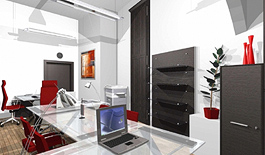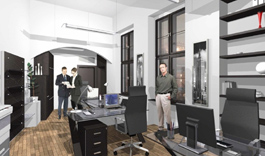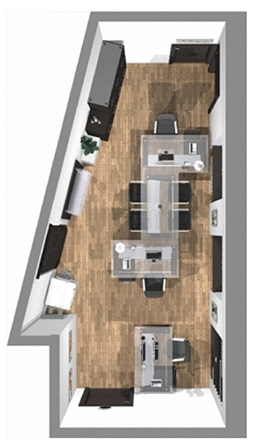
Visualization: from drawing to photograph
 |
Free visualization in three steps
The visualization process includes creating a 2D space plan, a three-dimensional wireframe model, and a photorealistic 3D model of the future office. If furniture elements from TOP OFFICE's range are used for visualization, the customer receives a design package for free.
Creating the basic proposal is preceded by space planning. Based on information from the client, the architect proposes the concept of office furnishings and the layout of individual furniture elements. At this stage, the TOP OFFICE design team continuously communicates with the customer and incorporates their feedback into the two-dimensional space plan.
 |
What precedes visualization?
 |
The customer must also specify whether personnel development is anticipated in the company. “If the client knows that the company will grow by several employees over the next few years, the office space will remain open for further changes. In the opposite case, the space will be closed,” adds Martin Chovanec. A thorough measurement of the space is also part of the preparatory phase.
Visualization is carried out by a special architectural team
For creating visualizations, TOP OFFICE has a team of architects who are trained in designing office interiors. “Our employees have special knowledge regarding lighting, IT, workplace ergonomics, and prescribed standards for offices,” says the marketing director of TOP OFFICE. In the area of employee training, TOP OFFICE collaborates with architect Hynek Maňák.Visualizations are created in the Turbo CAD Professional program. For simpler projects, the complete visualization is ready within two days. More complex proposals are processed by the expert team within ten days.
Do customers utilize design services, or do they prefer to rely on their own capabilities? Read the interview with architect TOP OFFICE Ing. Martin Janča.
More information about TOP OFFICE's design services can be found on the website www.top-office.cz.
“People rely on architects more often than in the past”
 |
How significant a role do you think visualization plays in closing a contract with a client?
The visual presentation of the proposal undoubtedly plays a significant role in closing a contract with a client, as do the price and the solution of the proposal. With the visualization of the proposal, the client has the opportunity to see what their office will look like before implementation takes place, which is always a “plus” for them.
Do customers approach architects more often than in the past, or is there still a belief that they can arrange the furniture themselves in the room?
In general, it can be said that customers are increasingly relying on the architect's experience. They want the best possible result while meeting their tailored ideas and requirements. Therefore, most clients prefer to seek an architect who can combine their ideas with general principles of a well-functioning office.
What services within visualization do customers most often utilize? Do they also seek advice on accessories and wall colors?
This cannot be generalized. Requirements are individual from client to client. Some require a proposal from A to Z, while others do not. However, it is a fact that proposals from our architectural department include everything that could be offered as a service within a complete proposal, including expert consultations. Our visual proposals always standardly include carpet design, wall painting, lighting, window shades, table and standing lamps, conference seating, paintings, flowers, and minor daily accessories.
What mistakes can customers make when designing the furniture layout themselves?
Mistakes can, in my opinion, arise from a lack of knowledge of the industry disciplines used in design, such as ergonomics, workplace zoning and its furnishing, use of color schemes in practice, selection and combination of materials, natural versus artificial lighting in the space, and so on.
What is the most interesting project you have worked on?
One of the most interesting projects was the KROFIAN project, industrial automation in Dobranov. It was one of the more extensive and atypical “turnkey” interiors. It was challenging, but it was successful. Another, equally interesting project I consider is the Barum center in Prague. The large project for a nation-wide recognized company took place in several phases, from space planning to detailed visualizations. I also fondly remember the Dodaco Electronic project from Valašské Meziříčí. It was an honor for me to design the interiors of an entire company based in the town where I come from.
Can we see your projects somewhere?
You can personally view all projects on our website www.top-office.cz, where in the reference tab, you will find photos of implementations that, I believe, speak for themselves.
The English translation is powered by AI tool. Switch to Czech to view the original text source.






